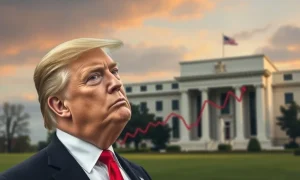A recent report concerning a potential $500 billion decision regarding Fannie Mae and Freddie Mac has certainly turned heads on Wall Street. This significant development could profoundly reshape the housing finance landscape. Investors, analysts, and policymakers are closely watching for further details on the reported Trump Fannie Freddie move.
The news signals a potential shift in the government’s long-standing involvement with these critical entities. For years, Fannie Mae and Freddie Mac have operated under conservatorship. Now, a new direction appears possible, generating considerable buzz in financial circles. Therefore, understanding the implications of this reported Trump Fannie Freddie decision becomes paramount for anyone interested in the future of the housing market.
Understanding Fannie Mae and Freddie Mac’s Role
Fannie Mae and Freddie Mac are government-sponsored enterprises (GSEs). They play a vital role in the United States’ housing finance system. Specifically, they purchase mortgages from lenders, package them into mortgage-backed securities, and then sell these securities to investors. This process provides liquidity to the mortgage market, allowing lenders to offer more loans to homebuyers.
Their primary function ensures a stable and affordable supply of mortgage credit. Without these entities, the housing market would face significant challenges. However, their structure and operations came under intense scrutiny during the 2008 financial crisis. Both companies required a massive government bailout. Consequently, they entered into conservatorship under the Federal Housing Finance Agency (FHFA).
Under conservatorship, the government effectively controlled their operations and claimed their profits. This arrangement was intended to stabilize the housing market and prevent future crises. Despite this, the long-term status of Fannie Mae and Freddie Mac has remained a subject of ongoing debate. Many stakeholders have called for a comprehensive reform of the housing finance system, setting the stage for the potential Trump Fannie Freddie plan.
The Reported Trump Fannie Freddie Plan Unveiled
Recent reports suggest a substantial shift in the government’s approach to Fannie Mae and Freddie Mac. The reported Trump Fannie Freddie plan involves releasing both entities from government conservatorship. This move would effectively return them to private control. Furthermore, it could involve a significant recapitalization of the companies.
The reported $500 billion figure indicates the potential scale of this financial undertaking. Such a large sum suggests a comprehensive strategy for their independence. Key aspects of the rumored plan include:
- Ending Conservatorship: This would remove direct government control over their daily operations.
- Recapitalization: A substantial financial injection would bolster their capital reserves.
- Dividend Suspension: Profits would likely be retained to build capital, rather than sent to the Treasury.
- New Regulatory Framework: A revised oversight structure would accompany their transition to private entities.
This potential change marks a significant departure from the post-crisis status quo. It reflects a desire to reduce the government’s footprint in the housing market. Thus, the Trump Fannie Freddie decision holds immense implications for the broader economy.
Wall Street’s Immediate Reaction to Trump Fannie Freddie News
The mere report of the Trump Fannie Freddie decision sent ripples across Wall Street. Investors reacted swiftly to the news. Shares of Fannie Mae and Freddie Mac, which trade on the over-the-counter market, saw notable price movements. This volatility reflects the high stakes involved in their future status.
Many investors who hold preferred shares in the GSEs have long awaited such a development. They anticipate the possibility of receiving dividends once the companies are out of conservatorship. Therefore, the news sparked optimism among these shareholders. Conversely, some analysts expressed caution. They highlighted potential risks associated with removing the explicit government guarantee.
Financial institutions, including banks and mortgage lenders, also closely monitor these developments. A privatized Fannie Mae and Freddie Mac could alter the landscape for mortgage originations and securitization. Consequently, lenders might need to adapt their strategies. The overall sentiment on Wall Street remains a mix of excitement and careful evaluation regarding the Trump Fannie Freddie plan.
Potential Economic Impacts of Trump Fannie Freddie Reform
The proposed Trump Fannie Freddie reform carries significant potential economic impacts. Firstly, it could influence mortgage rates. If the GSEs are fully privatized, their funding costs might increase. This could translate into slightly higher mortgage rates for consumers. However, proponents argue that a more competitive private market could also lead to efficiencies.
Secondly, the housing market itself could experience shifts. A stable, well-capitalized secondary mortgage market is crucial for housing affordability. The success of the reform hinges on ensuring this stability. Furthermore, the government’s role as a guarantor of last resort would need clear definition. This avoids future taxpayer bailouts.
Economists are analyzing various scenarios. Some predict increased private sector participation in housing finance. Others warn of potential systemic risks if not managed carefully. Ultimately, the long-term economic effects of the Trump Fannie Freddie decision will depend on the specifics of the final policy and its implementation. Policymakers must balance market efficiency with consumer protection.
Navigating the Future of Trump Fannie Freddie
Navigating the future of Trump Fannie Freddie involves complex regulatory and legislative challenges. The transition from conservatorship to full privatization requires careful planning. Policymakers must establish a robust regulatory framework. This framework will ensure the stability and soundness of the housing finance system post-conservatorship. Moreover, it must prevent a repeat of past financial crises.
Legal hurdles also exist. Shareholder lawsuits related to past government actions could complicate the process. Therefore, any reform must address these legal considerations comprehensively. The political will to push through such significant changes is also a key factor. Different stakeholders hold diverse views on the optimal path forward for Fannie Mae and Freddie Mac.
The coming months will likely bring more clarity on the specifics of the Trump Fannie Freddie proposal. The market will continue to scrutinize every detail. Its successful implementation could redefine housing finance for decades. Conversely, missteps could introduce new uncertainties. This makes the ongoing developments critically important for the entire financial ecosystem.
The reported $500 billion Trump Fannie Freddie decision has undeniably captured Wall Street’s attention. This potential move signifies a monumental shift in the government’s relationship with the housing finance giants. It promises to usher in a new era for Fannie Mae and Freddie Mac, moving them closer to full privatization. While the exact contours of the plan are still emerging, its implications for investors, homeowners, and the broader economy are profound. The coming period will reveal how this ambitious reform unfolds and reshapes the future of American housing finance.
Frequently Asked Questions (FAQs) About Trump Fannie Freddie Decision
What are Fannie Mae and Freddie Mac?
Fannie Mae and Freddie Mac are government-sponsored enterprises (GSEs). They buy mortgages from lenders, package them into securities, and sell them to investors. This process provides liquidity to the mortgage market, ensuring the availability of home loans.
Why are Fannie Mae and Freddie Mac under conservatorship?
They entered conservatorship in 2008 during the financial crisis. Both companies faced insolvency due to massive losses from subprime mortgages. The government intervened to stabilize them and the broader housing market, providing a bailout of over $187 billion.
What does the reported $500 billion Trump Fannie Freddie decision entail?
The reported decision suggests a plan to release Fannie Mae and Freddie Mac from government conservatorship. This would return them to private control. It also includes a significant recapitalization, potentially totaling $500 billion, to build their financial strength.
How might this decision impact mortgage rates?
If Fannie Mae and Freddie Mac are fully privatized, their funding costs might increase without an explicit government guarantee. This could potentially lead to slightly higher mortgage rates for consumers. However, market competition could also mitigate this effect.
What is Wall Street’s reaction to the Trump Fannie Freddie news?
Wall Street has reacted with significant interest and some volatility. Shares of Fannie Mae and Freddie Mac saw movements. Investors holding preferred shares are generally optimistic, hoping for dividend payments. Analysts, however, are weighing the potential benefits against the risks of reduced government backing.
What are the long-term implications of this Trump Fannie Freddie reform?
The long-term implications include a potentially more privatized housing finance system. It could reduce taxpayer exposure to mortgage market risks. However, it also requires a robust new regulatory framework to ensure market stability and prevent future crises.
























